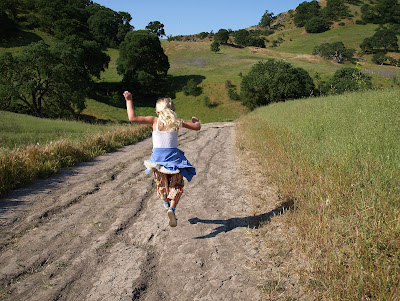
The newsletter from G/Son's Montessori school (sent via paperless e-mail, the better to be shared w/ loving Nonnas!) has a wonderful article about helping each child to find a "sitting space" outside, someplace the child can go to to feel safe, alone, in nature.
Did you have a place like this, as a child?
When I was young, my sitting space was under a giant, old forsythia bush, big enough to have multiple rooms inside it, where you could crawl in under the branches and feel that you were, indeed, in your own little world. I made tea-sets out of sycamore leaves, stitched into little cups with their stems, crawled in there to read without being bothered, lay on my back and learned more than I knew at the time by watching how the sunlight filtered through the leaves and golden flowers.
When I got a bit older, I graduated to a secret cave made by three ancient pine trees, off in the far SouthWest of our yard, sappy branches for climbing and all. The needles made a fragrant bed and no sunlight penetrated here. I went there to "play Indian," "Indian" being about the only model I had for living in relationship with nature. I hid treasures there, watched the ants make colonies, and climbed up higher than my parents would have liked.
When I got even older, my sitting space was down beside a local creek, where I could watch water dance and play with stones, where I could project myself into dragonflies, skimming over the water, where I could put my hands on the sandy bank and believe myself home.
The newsletter from G/Son's school makes the point that ensuring a child a "sitting space" helps the child to develop a relationship with nature, especially as it changes from season to season. There's no program or structure. There's just a child, a special place, time, and nature.
I was thinking today that the concept reminds me of the speech that Le Petit Prince makes to the Earthly roses:
You are beautiful, but you are empty. One could not die for you. To be sure, an ordinary passerby would think that my rose looked just like you — the rose that belongs to me. But in herself alone she is more important than all the hundreds of you other roses: because it is she that I have watered; because it is she that I have put under the glass globe; because it is she that I have sheltered behind the screen; because it is for her that I have killed the caterpillars (except the two or three that we saved to become butterflies); because it is she that I have listened to, when she grumbled, or boasted, or ever sometimes when she said nothing. Because she is my rose.
Except that, I think that the opposite thing happens. When one learns to enter into relationship with one particular bit of nature, when one learns to communicate with the genius loci of one place, one comes, somehow to a deeper appreciation of all nature.
But I do think it is Le Petit Prince's practice that is important: watering one's rose, protecting it, sheltering it, killing (some of) the caterpillars for it, and listening to it, even when the rose grumbles (every rose I ever tried to raise did), boasts, or says nothing. And, that, I think, is the value, for both children and grown-ups, of a sitting place. Do you have one? Does the child in your life?
Nowadays, my sitting place is in my woodland garden, near my magnolia trees, beside the ferns, just near the spot where I make Hecate's depinion on the Dark Moon. And, of course, I can't go there w/o reciting to myself David McCord's wonderful poem:
This is my rock
And here I run
To steal the secret of the sun.
This is my rock
And here come I
Before the night has swept the sky.
This is my rock
This is the place
I meet the evening face to face.
If you don't have a "sitting space" how could you find one?
Picture found here.



